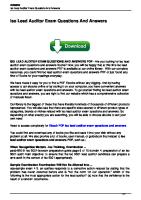PCR Questions and Answers Sep Pages [PDF]
PCR questions and answers 1. What are the three basic steps of conventional PCR? a. Denature, anneal, & strand displacem
47 0 61KB
Papiere empfehlen
![PCR Questions and Answers Sep Pages [PDF]](https://vdoc.tips/img/200x200/pcr-questions-and-answers-sep-pages.jpg)
- Author / Uploaded
- Mohita Chugh
Datei wird geladen, bitte warten...
Zitiervorschau
PCR questions and answers 1. What are the three basic steps of conventional PCR? a. Denature, anneal, & strand displacement b. Denature, anneal & extension c. Strand displacement, synthesis & release d. Reverse-transcription, anneal & extend 2. Which of the following is not a stage of PCR a. Decay b. Plateau c. Stochastic / lag d. Exponential 3. A PCR efficiency of ‘2’ means a. 100% efficiency / initial target copies are doubled by the end of the reaction b. 95% efficiency / each target copy is doubled every cycle c. 100% efficiency / each target copy is doubled every cycle d. 95% efficiency / initial target copies are doubled by the end of the reaction 4. RNA is copied into complementary DNA (cDNA) by: a. Taq DNA polymerase b. RNA polymerase II c. Reverse transcriptase d. Uracil-N-Glycosylase 5. The reverse transcriptase reaction can be primed by a. Target sequence specific primers b. Random hexamers c. Oligo dT primers d. All of the above 6. The cycle threshold is: a. The total number of cycles performed during a real-time PCR reaction b. The cycle that a sample crosses a certain point during a real-time PCR reaction c. The cycle number that a sample enters the plateau phase of PCR d. None of the above 7. Which of the following statements is false? a. PCR inhibitors can lead to false negative results b. PCR examines a large proportion of the tissue leading to false positive results c. Pathogen diversity at primer sites may lead to false negative results d. Contamination may lead to false positive results 8. Which of the following is an advantage of nested PCR (nPCR)? a. Provides a quantitative assessment of initial starting copy number
b. Second round PCR products can be a source of laboratory contamination c. Is less time consuming than single round conventional PCR d. Typically has high sensitivity and specificity 9. Which of the following is not an advantage of quantitative PCR (qPCR) a. Reliable indicator of viable infection b. No post-PCR handling of products c. Highly sensitive, specific and repeatable d. Can obtain quantitative results 10. Which is not a property of real-time PCR assays? a. Incorporate dyes that bind double-stranded DNA b. Incorporate an internal hydrolysis probe c. Be performed at single temperature with no specialized instrumentation required d. Be interpreted as a plus / minus result or as a quantitative result 11. A plasmid encoding a target sequence of interest will be used as the quantitative PCR standard. Where should you work with the plasmid? a. The PCR reagent clean area b. A special area designated for high risk templates c. The area where all sample templates are prepared d. None of the above 12. Ruggedness is defined as a. Reproducibility of an assay using different reagent brands or batches and different equipment b. The minimum number of copies reliably detected by the assay c. Agreement between sample replicates, both within an assay run and between independent assay runs, when tested by the same laboratory a. Agreement among test results when the same samples is tested by different laboratories 13. Analytical specificity is defined as a. The minimum number of copies reliably detected by the assay b. The intended purpose of the assay c. Agreement between sample replicates, both within an assay run and between independent assay runs, when tested by the same laboratory d. The degree to which the assay does not detect (amplify) other pathogens 14. The limit of detection is synonymous with a. Repeatability b. Analytical specificity c. Analytical sensitivity d. Ruggedness
15. The multistage process that evaluates an assay’s fit for intended purpose is called: a. Validation b. QA / QC c. Accreditation d. None of the above 16. Choose the statement that correctly finishes the sentence: “A PCR reaction that contains only one copy of the target sequence (1 copy /reaction)… a. is typically amplified in a highly repeatable manner” b. may amplify but is detection is not likely to be highly repeatable” c. can be precisely and accurately quantified using quantitative PCR” d. All of the above 17. Which of the following is not a method for stabilizing RNA a. 95% ethanol b. Liquid nitrogen c. RNAlater 18. DNA is typically more stable than RNA a. True b. False 19. Flaming tools will eliminate DNA that may be cross-contaminate samples a. True b. False 20. Primers must be stored at -80°C a. True b. False 21. Samples of known concentration/copy number used to construct a standard curve are called: a. Controls b. Standards c. Exogenous normalizing variables d. Endogenous normalizing variables 22. Various samples that ensure the validity of positive and negative results are called a. Controls b. Standards c. Exogenous normalizing variables d. Endogenous normalizing variables 23. Tissue weight would be an example of a a. Control
b. Standard c. Exogenous normalizing variable d. Endogenous normalizing variable 24. Expression of a housekeeping gene would be an example of a a. Control b. Standard c. Exogenous normalizing variable d. Endogenous normalizing variable 25. RNA is highly stable and can be frozen and thawed many times without degrading. a. True b. False
Answers PCR v1 exam 2011 1 2 3 4 5 6 7 8 9 10 11 12 13 14 15 16 17 18 19 20 21 22 23 24 25
b a c c d b b d a c b a d c a b a a b b b a c d b









